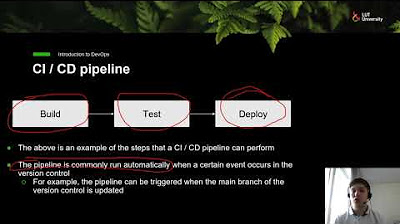IBM & Compuware: Mainframe DevOps Transformation Case Studies
Summary
TLDRThis video emphasizes the integration of DevOps practices within IBM, showcasing the transformation of zOS development through CI/CD pipelines. The speaker highlights the development of a supportive CI/CD community, the establishment of a standard toolset for zOS development, and significant improvements in deployment and testing efficiency. A key message is the need for the mainframe to be fully integrated into modern DevOps workflows, challenging the outdated 'two-speed IT' mindset. The speaker urges industry leaders to recognize that mainframes can, and should, embrace DevOps to drive efficient, unified development processes.
Takeaways
- 😀 Mainframes are increasingly being included in modern DevOps transformations, moving away from the traditional exclusion of the platform in digital transformation.
- 😀 IBM has adopted a comprehensive, integrated approach to DevOps, involving people, tools, and processes to modernize mainframe development and make it agile.
- 😀 The main goal of the transformation is to bring agility and speed to mainframe development, improving deployment times, testing, and overall software quality.
- 😀 IBM emphasizes the need for a unified, cross-functional DevOps team that brings together developers, operations, and business teams to support transformation.
- 😀 A dedicated DevOps community has been formed within IBM to share best practices and facilitate collaboration, using Slack channels and knowledge-sharing platforms.
- 😀 IBM's approach involves creating standardized topologies for mainframe development, which include essential tools like Jenkins, Rational Team Concert, and ZUnit for testing.
- 😀 The transformation process resulted in substantial improvements in deployment times, with deployments going from 3 days to just 30 minutes, and testing times reduced from 2 days to 20 minutes.
- 😀 The transformation also includes a focus on continuous integration and continuous delivery (CI/CD) practices to streamline the development pipeline and reduce manual effort.
- 😀 IBM advocates for the inclusion of mainframes in DevOps transformations to eliminate the so-called 'two-speed IT' and emphasize the value of mainframes in modern software development.
- 😀 There is a call to action for the community to challenge the outdated view of mainframes as incompatible with modern DevOps practices, and to encourage wider adoption of mainframe DevOps.
Q & A
What is the main objective of transforming Mainframe software development practices?
-The primary objective is to adopt Agile and DevOps methodologies to accelerate innovation, improve collaboration, and ensure higher quality software delivery on Mainframe systems.
How did Compuware modernize their Mainframe development environment?
-Compuware modernized their Mainframe development environment by introducing integrated development tools like Topaz (an Eclipse-based IDE), and adopting a comprehensive toolchain involving Git, Jenkins, Jira, Confluence, and automated testing tools.
What are some of the key tools used by IBM in their DevOps transformation for Mainframe systems?
-IBM used tools such as ZOS Explorer, Kicks, Git, Jenkins, Rational Team Concert, and Zunit to create an integrated DevOps pipeline for Mainframe development, enabling automation and continuous integration.
What significant results were achieved by Compuware through their DevOps transformation?
-Compuware experienced a 7% reduction in customer-reported defects, doubled the number of code deliveries per developer per year, and significantly reduced deployment time from 3 days to 30 minutes.
How did IBM enhance the efficiency of their software delivery pipeline?
-IBM streamlined their software delivery pipeline by integrating tools like Jenkins for continuous delivery, resulting in monthly releases and a reduction in deployment times from days to minutes.
What role did automated testing play in the transformation process?
-Automated testing played a crucial role by ensuring continuous integration, validating code quality, and enabling faster detection of issues. Both Compuware and IBM used tools like Zunit and Topaz for Total Test to perform automated unit and integration testing.
Why is it important to include Mainframe systems in DevOps transformations?
-Including Mainframe systems in DevOps transformations is essential because it allows organizations to modernize their entire development pipeline, reducing silos between legacy and modern platforms, and ultimately improving collaboration, speed, and software quality.
What is the significance of the 'golden topology' mentioned by IBM in their transformation?
-The 'golden topology' refers to a standardized set of tools and products recommended for Mainframe development. It includes a prescribed set of tools, such as Jenkins and Zunit, that ensure consistency across the organization and simplify the DevOps implementation.
How does the DevOps transformation impact collaboration within development teams?
-The DevOps transformation fosters better collaboration by integrating various teams and tools, allowing for real-time communication and issue resolution. For example, IBM used Slack channels for team collaboration and sharing best practices.
What is the concept of 'two-speed IT,' and why is it considered ineffective in DevOps transformations?
-The concept of 'two-speed IT' refers to the idea of treating Mainframe systems as separate from the rest of the IT landscape. It is considered ineffective because it creates silos and inefficiencies. A unified, multi-speed approach that includes Mainframe systems is crucial for seamless DevOps adoption across all platforms.
Outlines

Cette section est réservée aux utilisateurs payants. Améliorez votre compte pour accéder à cette section.
Améliorer maintenantMindmap

Cette section est réservée aux utilisateurs payants. Améliorez votre compte pour accéder à cette section.
Améliorer maintenantKeywords

Cette section est réservée aux utilisateurs payants. Améliorez votre compte pour accéder à cette section.
Améliorer maintenantHighlights

Cette section est réservée aux utilisateurs payants. Améliorez votre compte pour accéder à cette section.
Améliorer maintenantTranscripts

Cette section est réservée aux utilisateurs payants. Améliorez votre compte pour accéder à cette section.
Améliorer maintenantVoir Plus de Vidéos Connexes

Introduction to DevOps - CI / CD

CI / CD for Power BI with Azure DevOps & Microsoft Fabric – Episode 2: Continuous Integration

Day-18 | What is CICD ? | Introduction to CICD | How CICD works ? | #devops #abhishekveeramalla

GitLab: DevSecOps: Part 1/12: What is GitLab? The fundamental concepts of a DevSecOps pipeline.

#1 What is DevOps ,Agile and CICD

What is CICD Pipeline? CICD process explained with Hands On Project
5.0 / 5 (0 votes)
